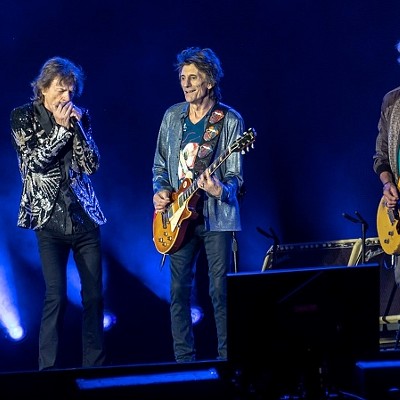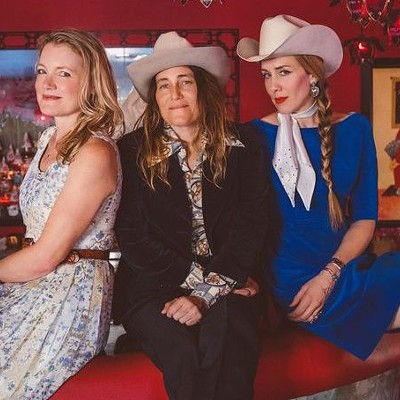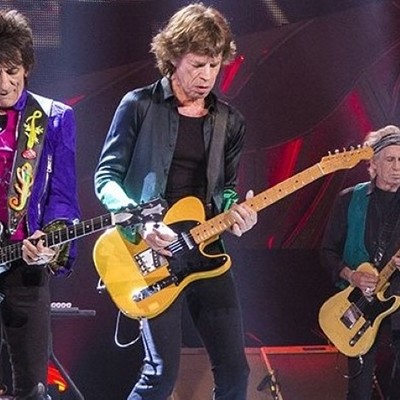Those who attended the inaugural year of Day For Night festival might recall The Infinity Room by Refik Anadol, a claustrophobic mirrored box filled with rhythmically fluctuating silvery light. The installation exemplified the festival's ethos: bright, experimental, and constantly in flux. In that first year, Day For Night proved itself to be a festival looking forward, a brave refashioning of what the bland music-festival circuit had come to be. And this year's festival, with its new Cold War-era venue and bombshell lineup including Aphex Twin and Björk, promises to renew its commitment to a strange, dark and totally unique spirit.
"The visual arts are a part of the festival's DNA," says co-creator Omar Afra. The iconic Day For Night light installations were one of the reasons organizers chose to move the festival from Silver Street Studios to the former Barbara Jordan Post Office, the 1962 municipal building that comes complete with its own bomb shelter. The new space offers more expansive square footage and an ominous vibe, but it also offers another key element: change. "So many festivals are at the same spot every year," says Afra. "If you've been to Bonnaroo or ACL five times, the stages are in the same place, the food is in the same place, the place you got your light beer is in the same place, and really the only thing that is different are the musical acts." Afra wanted a venue that would help create a "new anxiety" with each annual festival; the brooding nooks and crannies of the abandoned post office serve as a promising setting for the festival's mercurial aesthetic.
Afra knows well the pall cast over music festivals in general and EDM festivals in particular. After the death of 18-year-old Megan Tilton at the 2016 Free Press Summer Fest and the tragic fire at the Oakland DIY venue Ghost Ship, safety is an uneasy specter for events that walk the tight rope between good times and liability. But Afra's encyclopedic knowledge of evacuation plans, sprinkler systems, fire marshals, EMTs, roaming staff, ingress/egress and other safety measures suggested his personal investment in aggressive due diligence. As for the risk of illegal drug use by minors, the festival developed preventive measures like its high-school ambassador program, which awards students free passes if they pledge to attend the festival sober and arrange safe transit for fellow festivalgoers. "Kids are going to make mistakes, and they're going to make bad decisions, and we understand that," Afra says. "But we want to go to every length to make sure that when they're on our festival site, that they're safe and that they're in good hands."
The culture and demographic of Day For Night might make it less vulnerable to the kinds of liabilities found at is summer counterpart, FPSF. Afra reported that the average age at FPSF has gone down to about 19, whereas last year, the average age at Day For Night was about 26 or 27. He suspected that the maturity of the audience, alongside their relative experience with various and sundry levels of festival hedonism, would temper the more egregious acts of indulgence. He also thought the festival's large influx of out-of-towners — which he estimates will reach a number of at least 15,000 — would limit indiscretion with drugs and alcohol.
Day For Night is also looking out for women, in ways large and small. The festival partnered with Planned Parenthood in the wake of the U.S. presidential election, donating some of the proceeds of its ticket sales to the women's health organization. Further, almost every major management position—from the general manager to the creative director—is occupied by a woman. While the festival does better than most in terms of its support of female artists, Afra was quick to note "the fucking paradox" that emerges in the male-dominated music landscape. "It's ten times harder for females to get the airplay, promotions, and bookings that they deserve, but when the public speaks and votes with their dollars, they hoist women up to be ten times bigger than your average male artist," says Afra. "The public really, really wants these big female stars, and they want to see that part of music represented, but the industry isn't making that headway."
Day For Night is a grand-scale Houston experiment: our city's chance not to prove itself, but to prove that it no longer needs to prove itself. And that experiment ultimately just wants us to take a chance and experiment ourselves. Afra hopes that the festival becomes a longstanding institution where people can explore artistic and musical possibilities; he wants those who feel like they're merely knocking on the glass of a creative world to come in, feel invited, and get inspired. When asked what Day For Night would have to do in order to be a success this year, Afra replied simply: "I want it to make the hair on people's neck stand up."
Support Us
Houston's independent source of
local news and culture
account
- Welcome,
Insider - Login
- My Account
- My Newsletters
- Contribute
- Contact Us
- Sign out
[
{
"name": "Related Stories / Support Us Combo",
"component": "11591218",
"insertPoint": "4",
"requiredCountToDisplay": "4"
},{
"name": "Air - Billboard - Inline Content",
"component": "11591214",
"insertPoint": "2/3",
"requiredCountToDisplay": "7"
},{
"name": "R1 - Beta - Mobile Only",
"component": "12287027",
"insertPoint": "8",
"requiredCountToDisplay": "8"
},{
"name": "Air - MediumRectangle - Inline Content - Mobile Display Size 2",
"component": "11591215",
"insertPoint": "12",
"requiredCountToDisplay": "12"
},{
"name": "Air - MediumRectangle - Inline Content - Mobile Display Size 2",
"component": "11591215",
"insertPoint": "4th",
"startingPoint": "16",
"requiredCountToDisplay": "12"
}
,{
"name": "RevContent - In Article",
"component": "12527128",
"insertPoint": "3/5",
"requiredCountToDisplay": "5"
}
]
KEEP THE HOUSTON PRESS FREE...
Since we started the Houston Press, it has been defined as the free, independent voice of Houston, and we'd like to keep it that way. With local media under siege, it's more important than ever for us to rally support behind funding our local journalism. You can help by participating in our "I Support" program, allowing us to keep offering readers access to our incisive coverage of local news, food and culture with no paywalls.
Trending Music
- Top 10 Butt-Rock Bands of All Time
- Is Pink Floyd's A Momentary Lapse of Reason Misunderstood or Just Bad?
- An OG Beatles Fan Proves She Loved Them—Yeah, Yeah, Yeah!
-
Sponsored Content From: [%sponsoredBy%]
[%title%]

Don't Miss Out
SIGN UP for the latest
Music
news, free stuff and more!
Become a member to support the independent voice of Houston
and help keep the future of the Houston Press FREE
Use of this website constitutes acceptance of our
terms of use,
our cookies policy, and our
privacy policy
The Houston Press may earn a portion of sales from products & services purchased through links on our site from our
affiliate partners.
©2024
Houston Press, LP. All rights reserved.




